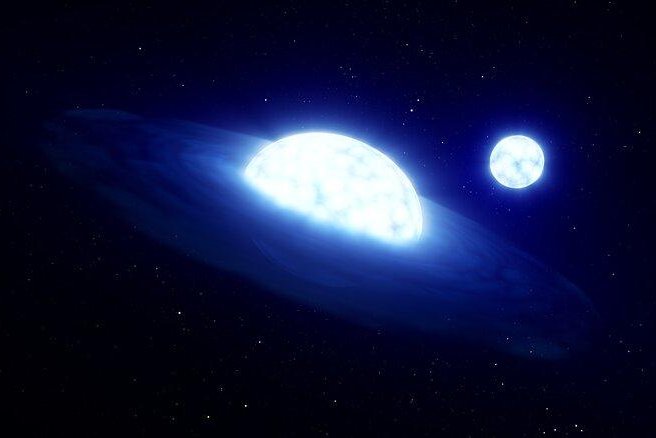By Calley Hair

New research indicates that HR 6819, previously believed to be a triple system with a black hole, is in fact a system of two stars with no black hole. This artist’s impression shows what the system might look like; it’s composed of a "vampire" star with a disc around it in the foreground and star that has been stripped of its atmosphere in the background. Illustration by L. Calçada/ESO
March 2 (UPI) -- Astronomers on Wednesday announced new findings indicating that an interstellar system 1,000 light years away from Earth does not actually include a black hole, a reversal of a previous observation.
If it did exist, the black hole in the HR 6819 system located in the constellation Telescopium would have been the closest to Earth. When a team of researchers examined the movement of two stars in 2020, the first star orbited the second while the second star moved in a wider orbit. They believed there had to be a black hole at the center to explain the pattern.
But astronomers now say it's a case of mistaken identity. The stars' movement is the result of a common but short-lived phenomenon called "stellar vampirism." One star is stripping away and absorbing mass from the other, according to the study published Wednesday in Astronomy & Astrophysics.
The debunking team included the scientist who thought he discovered the black hole two years ago, European Southern Observatory astronomer Thomas Rivinius, as well as ESO fellow Julia Bodensteiner and Abigail Frost of Belgian university KU Leuven.
"We agreed that there were two sources of light in the system, so the question was whether they orbit each other closely, as in the stripped-star scenario, or are far apart from each other, as in the black hole scenario," Rivinius said in an ESO press release.
To analyze fresh data, the team used an instrument on the ESO's Very Large Telescope called the Multi Unit Spectroscopic Explorer, as well as a tool on the Very Large Telescope Interferometer called GRAVITY.
"These data proved to be the final piece of the puzzle, and allowed us to conclude that HR 6819 is a binary system with no black hole," Frost said.
Frost, the new study's leader, added that catching a binary star system in a vampiric phase "is extremely difficult as it is so short."
"This makes our findings for HR 6819 very exciting, as it presents a perfect candidate to study how this vampirism affects the evolution of massive stars, and in turn the formation of their associated phenomena including gravitational waves and violent supernova explosions," Frost said.
Bodensteiner explained that the team likely observed the system just after one star had sucked the atmosphere off its companion, causing the vampire star to rotate more rapidly.
"This is a common phenomenon in close binary systems," Bodensteiner said.

No comments:
Post a Comment